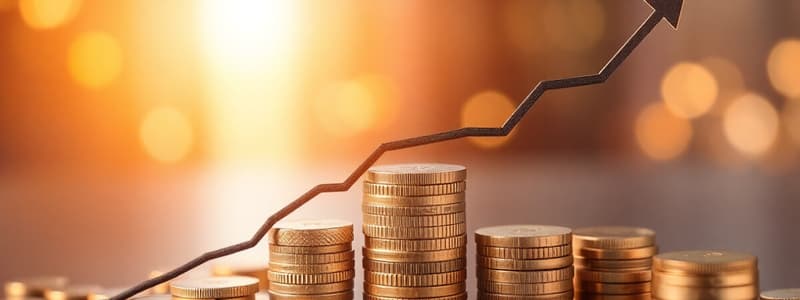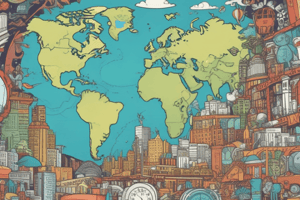Podcast
Questions and Answers
Which of the following scenarios is most likely to result in demand-pull inflation?
Which of the following scenarios is most likely to result in demand-pull inflation?
- A significant increase in the cost of raw materials for manufacturing.
- A rapid increase in government spending coupled with a substantial rise in consumer demand. (correct)
- A sudden decrease in consumer spending due to a loss of confidence in the economy.
- A widespread adoption of new technologies that automate production processes.
Which policy would be most effective in addressing structural unemployment in the long term?
Which policy would be most effective in addressing structural unemployment in the long term?
- Reducing government spending to balance the budget.
- Implementing job training programs to equip workers with skills demanded by employers. (correct)
- Lowering interest rates to stimulate overall economic demand.
- Increasing unemployment benefits to provide income support for the unemployed.
Suppose a country experiences a recession. Which fiscal policy action would be most appropriate to stimulate economic activity?
Suppose a country experiences a recession. Which fiscal policy action would be most appropriate to stimulate economic activity?
- Lowering taxes and increasing government spending on infrastructure projects. (correct)
- Increasing taxes to reduce the budget deficit.
- Decreasing government spending to control inflation.
- Maintaining the current levels of government spending and taxation.
What is the likely impact of a central bank implementing contractionary monetary policy?
What is the likely impact of a central bank implementing contractionary monetary policy?
What is the primary goal of inflation targeting as a monetary policy strategy?
What is the primary goal of inflation targeting as a monetary policy strategy?
Which of the following best describes the concept of the natural rate of unemployment?
Which of the following best describes the concept of the natural rate of unemployment?
What is the likely consequence of a country's central bank engaging in quantitative easing (QE)?
What is the likely consequence of a country's central bank engaging in quantitative easing (QE)?
Which factor is most directly associated with long-term economic growth?
Which factor is most directly associated with long-term economic growth?
If a country's GDP is growing at 3% and its population is growing at 2%, what is the approximate growth rate of GDP per capita?
If a country's GDP is growing at 3% and its population is growing at 2%, what is the approximate growth rate of GDP per capita?
Which of the following is the best example of a supply-side fiscal policy?
Which of the following is the best example of a supply-side fiscal policy?
Flashcards
Macroeconomics
Macroeconomics
The study of the economy as a whole, focusing on aggregate variables such as GDP, inflation, and unemployment.
Economic Growth
Economic Growth
The increase in the production of goods and services in an economy over a period of time, typically measured by the percentage increase in real GDP.
Inflation
Inflation
The rate at which the general level of prices for goods and services is rising, leading to a subsequent decrease in purchasing power.
Hyperinflation
Hyperinflation
Signup and view all the flashcards
Unemployment Rate
Unemployment Rate
Signup and view all the flashcards
Cyclical Unemployment
Cyclical Unemployment
Signup and view all the flashcards
Fiscal Policy
Fiscal Policy
Signup and view all the flashcards
Government Budget Deficits
Government Budget Deficits
Signup and view all the flashcards
Monetary Policy
Monetary Policy
Signup and view all the flashcards
Inflation Targeting
Inflation Targeting
Signup and view all the flashcards
Study Notes
- Macroeconomics studies the economy as a whole, focusing on aggregate variables like GDP, inflation, and unemployment.
- Economy-wide phenomena, including economic growth, business cycles, and price levels, are examined.
- Macroeconomic policies aim to stabilize the economy, promote growth, and maintain price stability.
Economic Growth
- Economic growth refers to the increase in the production of goods and services in an economy over a period of time.
- Typically measured by the percentage increase in real Gross Domestic Product (GDP).
- Sustained economic growth leads to higher living standards and improved quality of life.
- Factors driving economic growth include technological progress, capital accumulation, and labor force growth.
- Productivity growth, measuring how efficiently inputs are converted into outputs, is a key determinant of economic growth.
- Policies promoting economic growth include investments in education, infrastructure, and R&D.
- Supply-side economics focuses on policies to increase the aggregate supply of goods and services.
Inflation Dynamics
- Inflation is the rate at which the general level of prices for goods and services is rising, and subsequently, purchasing power is falling.
- Typically measured by the percentage change in the Consumer Price Index (CPI) or the GDP deflator.
- Demand-pull inflation occurs when aggregate demand exceeds aggregate supply, leading to upward pressure on prices.
- Cost-push inflation arises from increases in the costs of production, such as wages or raw materials.
- Inflation expectations play a crucial role in determining actual inflation rates.
- Central banks use monetary policy tools to manage inflation, such as adjusting interest rates.
- The Phillips curve illustrates the inverse relationship between inflation and unemployment.
- Hyperinflation is a very rapid and out-of-control increase in prices, often associated with monetary instability.
- Deflation, the opposite of inflation, is a sustained decrease in the general price level and can lead to decreased economic activity.
Unemployment Rates
- The unemployment rate is the percentage of the labor force that is unemployed and actively seeking employment.
- The labor force includes all individuals who are employed or unemployed but actively looking for work.
- Frictional unemployment occurs when workers are temporarily between jobs.
- Structural unemployment arises from a mismatch between the skills of workers and the requirements of available jobs.
- Cyclical unemployment is associated with fluctuations in the business cycle and occurs during recessions.
- The natural rate of unemployment is the sum of frictional and structural unemployment.
- Government policies, such as unemployment benefits and job training programs, can affect the unemployment rate.
- High unemployment can lead to decreased economic output, social unrest, and individual hardship.
Fiscal Policy
- Fiscal policy involves the use of government spending and taxation to influence the economy.
- Expansionary fiscal policy, such as increased government spending or tax cuts, aims to stimulate economic activity.
- Contractionary fiscal policy, such as decreased government spending or tax increases, aims to cool down an overheated economy and reduce inflation.
- Government budget deficits occur when government spending exceeds tax revenues.
- Government debt is the accumulation of past budget deficits.
- Fiscal policy can be used to stabilize the economy during recessions or to promote long-term economic growth.
- Automatic stabilizers, such as unemployment benefits, automatically adjust to stabilize the economy.
- The effectiveness of fiscal policy can be affected by factors such as the size of the multiplier effect and the level of government debt.
- Supply-side fiscal policies focus on tax cuts and deregulation to increase aggregate supply.
Monetary Policy
- Monetary policy involves the actions of a central bank to manipulate the money supply and credit conditions to stimulate or restrain economic activity.
- Central banks use tools such as open market operations, the reserve requirement, and the discount rate to influence interest rates and the money supply.
- Expansionary monetary policy, such as lowering interest rates or increasing the money supply, aims to stimulate economic growth.
- Contractionary monetary policy, such as raising interest rates or decreasing the money supply, aims to curb inflation.
- Inflation targeting is a monetary policy strategy where the central bank announces an explicit inflation target and uses its policy tools to achieve that target.
- The Taylor rule is a guideline for setting the federal funds rate based on inflation and output gap.
- The effectiveness of monetary policy can be affected by factors such as the liquidity trap and the zero lower bound.
- Quantitative easing (QE) is a monetary policy tool used by central banks to inject liquidity into the economy by purchasing assets.
- Monetary policy operates with a lag, meaning that the effects of policy changes are not immediately felt in the economy.
Studying That Suits You
Use AI to generate personalized quizzes and flashcards to suit your learning preferences.




